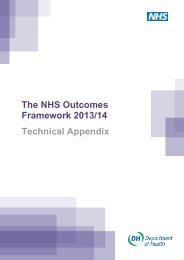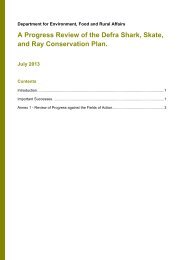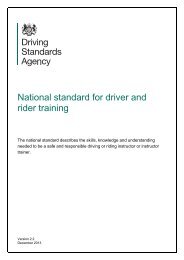<strong>Decontam<strong>in</strong>ation</strong>: Health Technical Memorandum 01-05 – <strong>Decontam<strong>in</strong>ation</strong> <strong>in</strong> <strong>primary</strong> <strong>care</strong> <strong>dental</strong> <strong>practices</strong> (2013 edition)• a basis for record<strong>in</strong>g the ma<strong>in</strong>tenancerequirements;• a basis for record<strong>in</strong>g and access<strong>in</strong>g <strong>in</strong>formationassociated with dis<strong>in</strong>fection and ma<strong>in</strong>tenance.19.31 When complet<strong>in</strong>g records, it is essential that the<strong>in</strong>dividual concerned signs and dates the entries,and that there is an audit trail <strong>in</strong> place.Water supply hygiene19.32 After any <strong>in</strong>stallation work, all pip<strong>in</strong>g, fitt<strong>in</strong>gs andassociated services used for the conveyance ofwater for domestic purposes must be dis<strong>in</strong>fectedbefore be<strong>in</strong>g brought <strong>in</strong>to use. The methodgenerally used for dis<strong>in</strong>fection is chlor<strong>in</strong>ation.Dis<strong>in</strong>fection us<strong>in</strong>g chlor<strong>in</strong>e should be carried out<strong>in</strong> accordance with BS EN 806-2:2005, BS EN806-3:2006 and BS 8558:2011 (see also HealthTechnical Memorandum 04-01 Part A Chapter17) and under the direct supervision of anom<strong>in</strong>ated person.19.33 Despite dis<strong>in</strong>fection of systems, some outbreaks ofdisease related to treated water supplies still occur.To reduce the risk of such outbreaks, the designshould elim<strong>in</strong>ate:• direct contact with the <strong>in</strong>ternal parts of waterpipes and structures by people, animals or birds(for example, ensure covers are <strong>in</strong> place onstorage tanks/cisterns);• backflow (back-siphonage) of contam<strong>in</strong>atedwater <strong>in</strong>to systems convey<strong>in</strong>g potable water(ma<strong>in</strong>s and storage structures).Water treatment19.34 In a properly <strong>in</strong>stalled and commissioned hotwater system, it should be possible to ma<strong>in</strong>ta<strong>in</strong> atemperature of at least 55oC at the furthest drawoffpo<strong>in</strong>t <strong>in</strong> the circulat<strong>in</strong>g system, and 50oC <strong>in</strong>the circulat<strong>in</strong>g system’s return connection to thecalorifier.19.35 In older premises, however, this may not bepossible, and <strong>in</strong> the case of cold water systems itis not always possible or practicable to ma<strong>in</strong>ta<strong>in</strong>water temperature below 20oC because ofutilisation and complexity. In addition, therefore,it may be necessary to apply a residual biocidalwater treatment that has been shown to destroyand remove biofilm. Information on thesetechniques, which <strong>in</strong>clude chlor<strong>in</strong>e dioxide andcopper and silver ionisation, can be found <strong>in</strong>Health Technical Memorandum 04-01 Part B.NoteIn addition to residual biocidal techniques, thereare other manufacturer-specified treatments that aredeveloped for use on DUWLs and other associated<strong>dental</strong> equipment. Refer to the manufacturer’s<strong>in</strong>structions for their correct use.19.36 Where automatic equipment is used fordis<strong>in</strong>fection, it should <strong>in</strong>dicate any change <strong>in</strong> theamount or concentration of material <strong>in</strong>jected <strong>in</strong>tothe water so that immediate action can be taken.19.37 Cont<strong>in</strong>uous dos<strong>in</strong>g with appropriate biocides thathave proven efficacy should be considered dur<strong>in</strong>gconstruction to prevent the accumulation ofbiofilm. A regular flush<strong>in</strong>g programme for alloutlets should also be implemented.19.38 The cont<strong>in</strong>uous chlor<strong>in</strong>ation of hot and cold waterservice systems to control the growth of Legionellais not generally recommended. Advice on the useof biocides should be sought from the personadvis<strong>in</strong>g the practice on Legionella.19.39 In def<strong>in</strong><strong>in</strong>g their responsibilities, service providersshould be asked to advise on test methods andanticipated concentrations of residual chemicalswith<strong>in</strong> the system. (See also Chapter 3 of HealthTechnical Memorandum 04-01 Part A for moreguidance on water treatment regimens.)Purg<strong>in</strong>g the systems19.40 Where chemical treatment is <strong>in</strong>troduced, it isessential to ensure that all parts of the systemare purged so that adequate concentrations areachieved.19.41 As temperature monitor<strong>in</strong>g is performed onsent<strong>in</strong>el and representative outlets on a roll<strong>in</strong>gbasis only, additional draw-off will be required atall po<strong>in</strong>ts on a regular basis.Ozone and ultraviolet treatment19.42 Whereas treatments such as chlor<strong>in</strong>e dioxide andcopper and silver ionisation are <strong>in</strong>tended to bedispersive (that is, they result <strong>in</strong> a residual agentwith<strong>in</strong> the system), ozone and ultraviolet are<strong>in</strong>tended to be effective close to the po<strong>in</strong>t ofapplication. They are not, therefore, necessarilyeffective <strong>in</strong> hot and cold water service systems (seeChapter 15 of Health Technical Memorandum04-01 Part A).70
19 Hot and cold water systems and <strong>dental</strong> unit water l<strong>in</strong>esMetal contam<strong>in</strong>ation19.43 See Health Technical Memorandum 04-01 Part AChapter 6.Filtration19.44 It is essential for filter cartridge elements to bechanged at appropriate <strong>in</strong>tervals <strong>in</strong> accordancewith the manufacturer’s recommendations, tak<strong>in</strong>g<strong>in</strong>to account local conditions.19.45 Filter membranes should also be chemicallycleaned or replaced at the recommended periods,and <strong>care</strong> must be taken to ensure that the “vessel”or “hous<strong>in</strong>g” conta<strong>in</strong><strong>in</strong>g the filter assembly isalso dis<strong>in</strong>fected appropriately dur<strong>in</strong>g filter ormembrane ma<strong>in</strong>tenance.Water storage19.46 For general <strong>in</strong>formation on water storage, seeHealth Technical Memorandum 04-01 Part A(paragraphs 7.1–7.2) and Health TechnicalMemorandum 04-01 Part B (paragraphs7.54–7.61).Cold water distribution system19.47 The design and <strong>in</strong>stallation of the cold waterdistribution system should comply with the WaterSupply (Water Fitt<strong>in</strong>gs) Regulations 1999 andrelevant parts of BS EN 806-2:2005, BS EN 806-3:2006 and BS 8558:2011. (See Chapter 8 ofHealth Technical Memorandum 04-01 Part A forfurther <strong>in</strong>formation.)19.48 The control of water temperature <strong>in</strong> the cold waterservice will essentially rely on good <strong>in</strong>sulation andwater turnover. Cold water services should be sizedto provide sufficient flow and should be <strong>in</strong>sulatedand kept away from areas where they are prone tothermal ga<strong>in</strong>s (this also applies to water suppliesfor spittoons). Stagnation must be avoided. Specialattention should be given to the ma<strong>in</strong>tenance andmonitor<strong>in</strong>g of these systems.19.49 Schematic draw<strong>in</strong>gs of the system with numberedand labelled valves will reduce confusion and savetime <strong>in</strong> try<strong>in</strong>g to identify appropriate isolat<strong>in</strong>gvalves and other system components.19.50 Checks and actions should be carried out to showthat:• the system components show no sign of leakageor corrosion;• the system <strong>in</strong>sulation is <strong>in</strong> good condition;• the system filters have been changed and/orcleaned <strong>in</strong> accordance with manufacturer’srecommendations. Stra<strong>in</strong>ers should be checkedand cleaned regularly;• all isolat<strong>in</strong>g valves have periodically beenworked through their full range of travel;• every water outlet complies with the backflowprotection requirements of the Water Supply(Water Fitt<strong>in</strong>gs) Regulations 1999.Dr<strong>in</strong>k<strong>in</strong>g water19.51 If separate dr<strong>in</strong>k<strong>in</strong>g water supplies are provided,reference should be made to Health TechnicalMemorandum 04-01 Part A (paragraphs 8.13 and8.14).Hot water storage and distribution19.52 Hot water services should be designed and<strong>in</strong>stalled <strong>in</strong> accordance with the Water Supply(Water Fitt<strong>in</strong>gs) Regulations 1999 and relevantparts of BS EN 806-2:2005, BS EN 806-3:2006and BS 8558:2011. The hot water system may beof either the vented or the unvented type. (SeeHealth Technical Memorandum 04-01 Part AChapter 9 for further <strong>in</strong>formation.)19.53 To control possible colonisation by Legionella, itis essential to ma<strong>in</strong>ta<strong>in</strong> the temperature with<strong>in</strong> thehot water circulat<strong>in</strong>g system. To some extent, ifproperly ma<strong>in</strong>ta<strong>in</strong>ed, the calorifier/water heaterwill provide a form of barrier to Legionella andother water-borne organisms. The m<strong>in</strong>imum flowtemperature of water leav<strong>in</strong>g the calorifier/waterheater should be 60oC at all times and 55oC at thesupply to the furthermost draw-off po<strong>in</strong>t <strong>in</strong> thecirculat<strong>in</strong>g system.NotesA m<strong>in</strong>imum of 55oC may be required for theoperation of suitable mix<strong>in</strong>g devices to provide “safe”hot water at the upper limit of the recommendedrange.In large non-recirculat<strong>in</strong>g systems, the m<strong>in</strong>imum of55oC should be ma<strong>in</strong>ta<strong>in</strong>ed by electric trace-heat<strong>in</strong>g.19.54 The m<strong>in</strong>imum water temperature at theconnection of the return to the calorifier/waterheater should be 50oC. To achieve the requiredcirculat<strong>in</strong>g temperatures, it will be necessary toma<strong>in</strong>ta<strong>in</strong> the balance of flows to <strong>in</strong>dividual pipebranches and draw-off po<strong>in</strong>ts.71
















